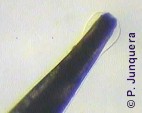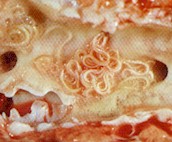Dictyocaulus is a genus of very harmful parasitic roundworms that infects cattle, sheep, goats, horses and many other domestic and wild mammals.
that infects cattle, sheep, goats, horses and many other domestic and wild mammals.
It is found worldwide, particularly in regions with temperate or cold climate, especially in those with heavy rainfall.
These worms do not affect pigs, dogs or cats.
The most relevant species for livestock are:
- Dictyocaulus filaria infects mainly sheep and goats as well as camelids and other wild ruminants (antelopes, deer, etc.).
- Dictyocaulus viviparus infects mainly cattle and other bovids, as well as camelids, deer, elk, reindeer, etc.
- Dictyocaulus arnfieldi infects horses, donkeys, mules and other equines.
The disease caused by Dictyocaulus worms is called dictyocaulosis, verminous bronchitis or lung verminosis.
In sheep and goats they appear often in mixed-infections together with so-called small lungworms of small ruminants (e.g. Muellerius capillaris, Protostrongylus rufescens).
Is livestock infected with Dictyocaulus worms contagious for humans?
- NO: The reason is that these worms are not human parasites.
You can find additional information in this site on the general biology of parasitic worms and/or roundworms.
Final location of Dictyocaulus worms
Predilection sites of adult Dictyocaulus worms are trachea, bronchi and bronchioles. Migrating larvae can be found in numerous organs: gut, lymph nodes, thoracic duct (the largest lymph vessel), jugular vein and heart.
Anatomy of Dictyocaulus worms
Adult Dictyocaulus worms are slender, medium sized roundworms, up to 8 cm long. Females are about one third longer than males. They have a whitish to grayish color.
As in other roundworms, the body of these worms is covered with a cuticle, which is flexible but rather tough. The worms have a tubular digestive system with two openings. The gut of Dictyocaulus filaria is visible from outside as a dark line. They also have a nervous system but no excretory organs and no circulatory system, i.e. neither a heart nor blood vessels.
The female ovaries are large and the uteri open at the posterior end of the body. Males have a copulatory bursa with two short and thick spicules for attaching to the female during copulation.
The eggs of Dictyocaulus viviparus are ~35x85 micrometers, those of Dictyocaulus filaria and Dictyocaulus arnfieldi ~60x90 micrometers. They have and ovoid shape and contain a fully developed L1 larva.
Life cycle of Dictyocaulus worms

Dictyocaulus worms have a direct life cycle, i.e. there are no intermediate hosts involved. Adult females lay eggs in the airways of infected hosts. These eggs are transported to the pharynx within respiratory secretions. From the pharynx these eggs are coughed out, into the mouth to be swallowed or directly to the outside. Those that are swallowed release the L1 larvae in the gut, which are shed in the feces.
Once in the environment, L1-larvae develop to infective L3 larvae in about 1 week. These larvae show a low motility and remain close to the droppings. However, Dictyocaulus viviparus larvae often live on a fungus called Pilobolus that grows on cattle dung. When a Pilobolus sporangium bursts to expel the spores, Dictyocaulus larvae are projected up to 30 cm away from the droppings. Infective larvae are susceptible to dryness and usually they do not survive longer than about 1 month on pasture.
Livestock becomes infected mainly while grazing, but infection can also happen indoors through contaminated hay or bedding. Once ingested and in the host's gut infective larvae penetrate into the gut's wall and reach the lymphatic nodules where the molt to L4 larvae. Through the thoracic duct and the jugular vein they reach the heart and are pumped to the lungs. Once in the lungs they are stopped in the lung capillaries, cross their wall and reach the bronchioles, bronchi or the trachea where they complete development to adult worms.
The prepatent period (time between infection and first larvae shed with the feces) lasts about 4-5 weeks. However, larvae in the lungs may become arrested (dormant, hypobiotic, inhibited) for up to 5 months. These larvae resume development at early spring and re-infect the pastures during the next season.
Harm caused by Dictyocaulus worms, symptoms and diagnosis
Dictyocaulus is one of the most harmful roundworm for horses and ruminants in regions with temperate climate. It is the main responsible of verminous bronchitis in ruminants in endemic regions, particularly in intensive cattle operations. A few worms are usually not harmful, but massive infections can be fatal.
Young animals are more likely to suffer from Dictyocaulus infections, particularly during their first grazing season. Larvae in the lungs irritate the lining of the airways, which reacts increasing mucus production. This can congest and even obstruct the airways. Damaged cells of the lining are substituted by connective tissue (fibrosis), which reduces the respiratory capacity. Secondary infections with bacteria or viruses can also occur.
In case of massive infections, excessive eggs or larvae may cause pulmonary consolidation, i.e. filling of the alveolar space with foreign materials instead of air. Fatalities are frequent if the affected animals are not adequately treated.
Typical signs and symptoms are heavy coughing (often paroxysmal), accelerated and/or difficult breathing and nasal discharge. Affected animals lose appetite and weight. Severe infections can also cause pneumonia (lung inflammation), emphysema (over inflation of the alveoli), and pulmonary edema (liquid accumulation in the airways).
Among equids, donkeys may often carry large amounts of worms without showing clicinal symptoms. If kept together with horses, they are a substantial reservoir of infection for horses.
Adult animals usually develop resistance and if re-infected may not show clinical signs but continue shedding larvae that contaminate their environment.
Diagnosis is based on clinical symptoms and is confirmed by detection of larvae (not eggs!) in the feces (Baermann method).
Prevention and control of Dictyocaulus
Non-chemical prevention
Reducing pasture contamination with infective larvae is a key preventative measure that can be achieved to a large extent with adequate management measures.
Rotational grazing with a change interval of 4 days and keeping the paddocks empty for at least 40 days significantly reduces pasture contamination. This is due to the fact that larvae are susceptible to dryness and won't survive more than 4 or 5 weeks on pasture if they do not find an adequate host. Obviously, by very moist weather or where pastures are almost permanently moist survival may be longer.
Alternate grazing with sheep and/or horses may be considered, since Dictyocaulus species are quite host-specific (for cattle, sheep & goats, horses). The longer the absence of the specific host, the higher will be the reduction of its specific lungworm. However, this may not be advisable in places infected with gastrointestinal roundworms that are simultaneously parasitic of cattle and sheep or horses.
For their first grazing season it is highly advisable that young stock does not share the pastures with older stock that has been exposed earlier to infected grounds and can therefore shed larvae. It must also be avoided that young stock uses pastures already used by older stock during the same season.
It must also be considered that heavy rains and flooding can disseminate infective larvae inside a property or from one property to neighboring ones.
Keeping the pastures as dry as possible and keeping livestock away from places excessively humid are additional key measures to reduce the exposure of livestock to infective larvae.>
Since livestock and horses can become infected indoors, strict hygiene and sanitation of the facilities are essential: frequent manure removal and bedding replacement, keeping everything as dry as possible, etc. It is safer not to harvested hay from contaminated paddocks, or it must be thoroughly dried before usage.
Dictyocaulus species that infect livestock and horses can also infect numerous wild animals (deer, antelopes, etc.). If feasible, they should be kept off the pastures used by livestock.
Other preventative measures are similar than those against gastrointestinal roundworms and explained in a specific article in this site (click here).
Biological control of Dictyocaulus worms (i.e. using its natural enemies) is so far not feasible. Learn more about biological control of worms.
You may be interested in an article in this site on medicinal plants against external and internal parasites.
Chemical control
Numerous broad spectrum anthelmintics are effective against adult worms and larvae, including inhibited ones, e.g. several benzimidazoles (albendazole, febantel, fenbendazole, oxfendazole, etc.), levamisole, as well as several macrocyclic lactones (e.g. abamectin, doramectin, eprinomectin, ivermectin, moxidectin).
A few other narrow-spectrum anthelmintics such as tetrahydropyrimidines (e.g. morantel, pyrantel) and piperazine derivatives are not effective against these worms.
Numerous commercial products contain mixtures of two or even more active ingredients of different chemical classes. This is done to increase the chance that at least one active ingredient is effective against gastrointestinal worms that have become resistant, or to delay resistance development by those worms that are still susceptible.
Depending on the country most of these anthelmintics are available for oral administration as drenches, feed additives and/or tablets. Levamisole and most macrocyclic lactones are usually also available as injectables. A few active ingredients are also available for livestock as pour-ons and slow-release boluses. For horses most anthelmintic sare available as oral pastes or gels.
Excepting slow-release boluses, most wormers containing benzimidazoles (e.g. albendazole, febantel, fenbendazole, oxfendazole, etc.), levamisole, tetrahydropyrimidines (e.g. morantel, pyrantel) and other classic anthelmintics kill the worms shortly after treatment and are quickly metabolized and/or excreted within a few hours or days. This means that they have a short residual effect, or no residual effect at all. As a consequence treated animals are cured from worms but do not remain protected against new infections.
To ensure that they remain worm-free the animals have to be dewormed periodically, depending on the local epidemiological, ecological and climatic conditions. An exception to this are macrocyclic lactones (e.g. abamectin, doramectin, eprinomectin, ivermectin, moxidectin), that offer several weeks protection against re-infestation, depending on the delivery form and the specific parasite.
In some countries commercial vaccines are available against Dictyocaulus viviparous for cattle, and/or against Dictyocaulus filaria for sheep and goats. These vaccines are based on parasite larvae inactivated through irradiation. Vaccinated livestock can graze on contaminated pastures without become sick. To learn more about vaccines against parasites of livestock and pets click here.
In endemic regions preventative strategic treatment of young stock is often recommended just prior to their first grazing season, followed by additional treatments depending on the infestation level of the pastures and the residual effect of the administered anthelmintic.
Resistance of Dictyocaulus worms to anthelmintics
There are a few reports on resistance of Dictyocaulus worms to anthelmintics in cattle. However, this seems not to be such a serious and widespread problem as for several gastrointestinal worms (e.g. Haemonchus spp, Cooperia spp, Ostertagia spp, Trichostrongylus spp) etc.
This means that if an anthelmintic fails to achieve the expected efficacy against Dictyocaulus, there is a certain chance that it was due to resistance, but it is most likely that either the product was unsuited for the control of Dictyocaulus worms, or it was used incorrectly. Incorrect use is the most frequent reason for failure of antiparasitics.
Learn more about parasite resistance and how it develops.
|
Ask your veterinary doctor! If available, follow more specific national or regional recommendations for Dictyocaulus control. |